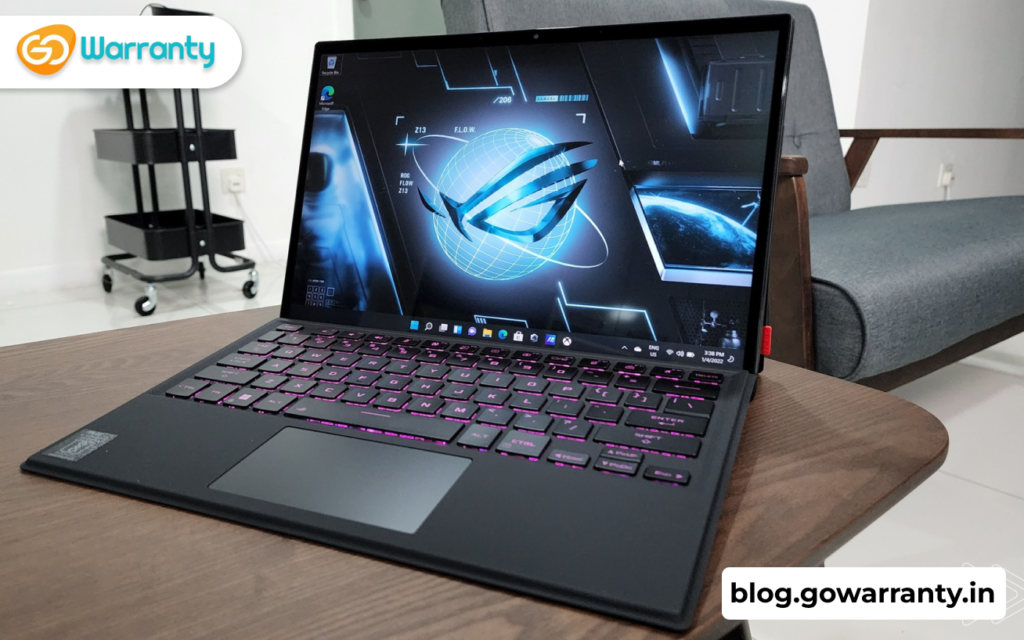The Flow Z13 is a one-of-a-kind product, a portable tablet+keyboard folio format with a 13-inch display, but it also has powerful specs that rival the capabilities of many full-size laptops. In fact, alongside the slightly higher-specced 2023 generation of the ROG Flow X13, the ROG Flow Z13 remains one of the most powerful 13-inch compact computers currently available in stores. On the surface, the 2023 Zephyrus Z13 update appears to be a hardware refresh of the 2022 Flow Z13 generation, since it’s built on the same chassis and has similar characteristics and functionality.
Design and Build
The overall design and functionality of the 2023 ROG Flow Z13 series have not changed in any way from the gen1 model, which was released last year. In a nutshell, the Flow Z13 is a tablet with a keyboard folio, similar to the Surface Pro, but slightly thicker and heavier, as well as incomparably more powerful. The 2023 generation weighs 1.2 kilos for the tablet and an additional.35 for the keyboard, for a total of 1.55 kilos. That’s a lot of weight for a 13-inch device. However, the internal hardware inside compensates for it.

As a tablet PC, this works best on a desk, as the ergonomics in any other situation are questionable. You could use it as a tablet for browsing, reading, and taking notes, but it’s clunky and heavy, and it’s also a Windows device, so it doesn’t come close to the experience provided by a dedicated tablet, such as an iPad. You may feel differently, at least for me.
Major Selling Point
The fact that the components are placed behind the screen is a major selling point for this tablet format, as it means that the keyboard folio always stays cool and comfortable to the touch, regardless of what you’re running on the device. Furthermore, the thermal module is never obstructed, as opposed to regular laptops, where the fans are placed beneath the main chassis with little room for proper airflow.
Furthermore, unlike many other ultraportables, the outputs are on the top edge, pushing hot air away from the chassis rather than into the screen. When combined with the advanced vapour-chamber cooling module found inside this device, the design allows Asus to cram powerful hardware into the Flow Z13 and even run it at significantly higher power levels.
Ports
One final point to mention is the IO. This device has two USB-C ports on the left side, a USB-A and a headphone jack on the right, and a microSD card reader on the back, under the kickstand. Unlike the previous generation, the USB-A slot on this generation is 3.2 gen1, and the two USB-C slots both support data, video (via the iGPU, one via the dGPU), and charging.
Keyboard and Touchpad
The ROG Flox Z13 includes a keyboard folio with an RGB backlit keyboard and a clickpad. The folio connects to the tablet via a physical connector, and magnets are strategically placed on the folio and the tablet’s bottom to aid in the docking process and make it as smooth as possible. That means the keyboard response is quick, with no lag associated with Bluetooth peripherals, but it also means you can’t use the keyboard when it’s not physically connected to the tablet.
For a more comfortable typing position, this keyboard can be used in two positions: flat on the desk and slightly angled. These two modes are typical for this type of device. The deck of this folio flexes slightly under the weight of your arms in bumped-up mode, but not in a way that interferes with typing.
Display
The ROG Flow Z13 series has a 13.4-inch 16:10 touch display with a single panel option for this generation: IPS QHD+ 165Hz. By today’s standards, this is a good and balanced screen, with excellent sharpness at this size, 500+ nits of brightness, as well as 100% DCI-P3 colour coverage. This is also a glossy touch implementation with a layer of Gorilla glass over the panel, but despite the associated glare, it is mostly bright enough to be usable in most conditions, such as outdoors or in bright office spaces.
This panel also has a 165Hz high-refresh rate and average response time, which are both essential features for a modern gaming computer. Furthermore, GSync is supported on the main display this year, preventing tearing in games.
Hardware and Performance
Our test model is a high-end Asus ROG Flow Z13, codenamed GV301VV, with an Intel Core i9-13900H processor, 16 GB of DDR5-4800 dual-channel memory, 1 TB of mid-tier SSD storage, and dual graphics: the Nvidia RTX 4060 8GB dGPU as well as the Iris UHD iGPU integrated within the Intel processor. Before we begin, keep in mind that our review unit was provided by Asus and runs on early software that was available as of early March 2023. (BIOS 301, Armoury Crate 5.4.10, GeForce 528.69 drivers). Some aspects of the software may change in the future. The 2023 ROG Flow Z13 is available with low and mid-tier RTX chips for the GPU. On this sample, we have the RTX 4060 Laptop dGPU, which can run at up to 65W with Dynamic Boost.
Battery Life
This ROG Flow Z13 has a 56 Wh battery, which is adequate for a 13-inch tablet with this kind of hardware and cooling. When using the laptop on battery power, the system is also set to automatically switch the screen refresh rate to 60 Hz. This Z13 generation comes with a 130W USB-C charger, which is larger and heavier than the previous model’s 100W charger. It’s a standard dual-piece design with two long cables that plug into either of the two ports on the left edge via USB-C.

